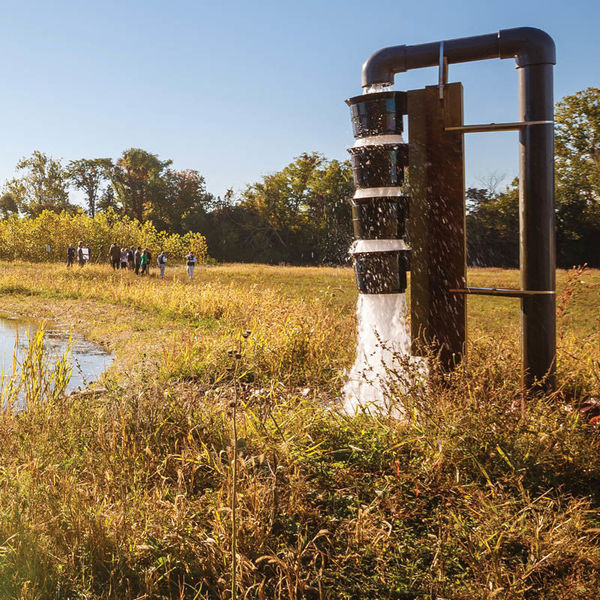Notre Dame ecosystem facility offers unique opportunity to develop more accurate models
 Professor Diogo Bolster
Professor Diogo Bolster
Although the United States had its industrial revolution in the 1800s, other countries are now experiencing their manufacturing boom in the 21st century. This means that more advanced manufactured materials are being produced, including, for example, engineered nanoparticles whose exact impact on the environment and human health are unknown, but whose effects could be quite negative. To better understand such threats, researchers are using the Notre Dame Linked Experimental Ecosystem Facility (ND-LEEF) to study how these engineered nanoparticles will move and spread in the natural environment.
In explaining this research, Diogo Bolster, associate professor and Frank M. Freimann Collegiate Chair in Hydrology and associate director of the Environmental Change Initiative, said, “When it comes to understanding how the natural environment works, it is imperative to realize how small differences can create very complex settings that profoundly impact how air or water flows through nature. For this study, we will develop models that can account for these complexities and still relay accurate data as it pertains to such small in size, yet significant, environmental contaminants.”
 Professor Kyle Doudrick
Professor Kyle Doudrick
For the project, Bolster and Kyle Doudrick, assistant professor of civil & environmental engineering & earth sciences, will use ND-LEEF, a globally unique research facility that houses two artificial experimental watersheds which each consist of a pond, streams, and wetland. This will provide the Notre Dame researchers the control needed to gather realistic data.
Bolster continued, “Experiments are vital to validating any theory, but when it comes to the natural environment, laboratories impose a level of control which limits the impact of your results. On the other hand, the limitation of using an actual stream or river is that you do not know enough about the body of water to make inferences about your theory. ND-LEEF provides the best of both: you can conduct large-scale experiments in a natural environment and also know the composition of all of the materials in the stream.”
 Linked Experimental Ecosystem Facility
Linked Experimental Ecosystem Facility
By utilizing this facility as well as laboratory experiments, the objective is to get more accurate results than a lab study could on its own. Subsequently, the research, which is funded by the National Science Foundation for more than $300,000, could also help inform environmental regulation agencies and contribute to the development of any new environmental legislation.
“As someone who focuses mostly on mathematical models, my research often benefits from partnerships with those who are more focused on field and lab experiments,” said Bolster in reference to his collaboration with Doudrick. “To me, this is one of ND-LEEF’s greatest successes because the facility creates a collaborative environment for not only those with differing research backgrounds but also provides a platform for cross-disciplinary conversations.”
ND-LEEF, which is part of the Environmental Change Initiative, is based in South Bend’s St. Patrick’s County Park. It hosts two replicated watersheds that each contain a linked stream, pond, and wetland that can be manipulated to test ecologically motivated hypotheses.
In addition to the aquatic resources, ND-LEEF has several shallow-groundwater monitoring wells. There are also several acres available for terrestrial research and a large gravel lay-down area for mesocosm experiments. Further, a newly constructed pavilion offers a venue for education and outreach programs.
ND-LEEF is available to Notre Dame researchers, other academic institutions, and industry. For more information, please visit eci.nd.edu.
Contact:
Brandi Klingerman / Communications Specialist
Notre Dame Research / University of Notre Dame
bklinger@nd.edu / 574.631.4166
research.nd.edu / @UNDResearch
About Notre Dame Research:
The University of Notre Dame is a private research and teaching university inspired by its Catholic mission. Located in South Bend, Indiana, its researchers are advancing human understanding through research, scholarship, education, and creative endeavor in order to be a repository for knowledge and a powerful means for doing good in the world. For more information, please see research.nd.edu or @UNDResearch.
Originally published by at research.nd.edu on November 16, 2017.